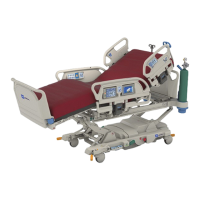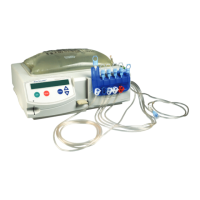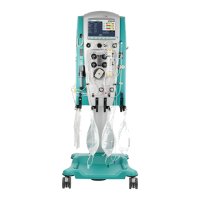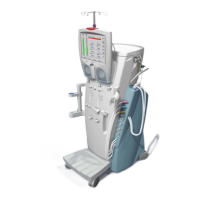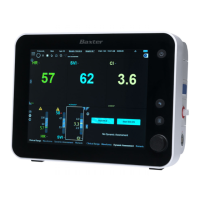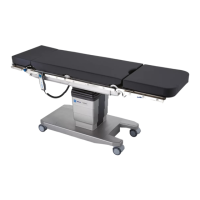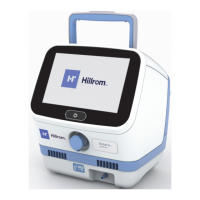
Do you have a question about the baxter Hillrom Volara PVL1 and is the answer not in the manual?
| Manufacturer | Hillrom |
|---|---|
| Model | Volara PVL1 |
| Category | Medical Equipment |
| Therapy | Airway Clearance Therapy |
| Power Source | AC Power |
| Operating Modes | Continuous, Intermittent |
| Frequency Range | 5-20 Hz |
| Compatibility | Compatible with vests and accessories |
| Connectivity | USB, Bluetooth |
Details the intended uses for secretion mobilization and lung expansion therapy.
Specifies age groups, settings, and users for Volara System therapy.
Explains how the Volara System enhances secretion mobilization and prevents atelectasis.
Specifies conditions absolutely preventing Volara System use.
Lists conditions requiring evaluation and potential side effects.
Explains document typefaces, symbols, and system device symbols.
Emphasizes reading all instructions before operating the system.
Recommends saving the safety instructions for future reference.
Identifies front and back view components of the Volara Control Unit.
Details the various components of the Volara System's patient circuit.
Warns against improper assembly and guides initial connection steps.
Details how to attach the breathing hose to the Smart-Filter.
Guides connecting the Smart-Filter to the therapy port and the handset.
Explains how to connect various patient interfaces to the system.
Details connecting the oxygen bleed-in adapter to the circuit.
Details initial setup, warm-up, cool-down, and powering on the unit.
Instructions for powering the system using its battery.
Describes the elements and options available on the Volara Home menu.
Explains the different sections and functions within the Volara Options menu.
Guides on positioning the interface and selecting therapy modes.
Provides steps to initiate therapy using manual mode.
Explains the screen layout and data displayed during automatic therapy.
Guides the user through starting a therapy session in automatic mode.
Explains how to control a therapy session (pause, resume, stop).
Details how to adjust pressure and control the nebulizer during therapy.
Explains how to adjust therapy frequency settings in CHFO mode.
Describes the screen layout and controls for manual therapy mode.
Details how to begin CPEP or CHFO stages in manual mode.
Explains how to select frequency and enable the nebulizer in manual mode.
Covers frequency and initial procedures for ventilator-assisted therapy.
Guides connecting the Volara patient circuit to a ventilator.
Guides on creating custom therapy plans with multiple stages.
Explains how to set pressure, duration, and nebulizer use for therapy stages.
Explains how to enable and adjust cough pause within preset therapies.
Guides on selecting and modifying parameters for individual therapy stages.
Explains how to enable and adjust cough pause within preset therapies.
Explains how to modify the screen brightness.
Guides on setting system date, time, time zone, and language.
Controls access to advanced features and settings for authorized users.
Allows enabling or disabling access to the manual therapy mode.
Configures the maximum allowable pressure setting for therapy.
Guides on pairing external devices like barcode readers and pulse oximeters.
Explains how to connect the system to a local wireless network.
Guides connecting the system to public WiFi networks.
Instructions for connecting to enterprise-level WiFi networks.
Details manual configuration of IP address, gateway, subnet, and DNS.
Guides on testing the EMR connection for data submission.
Explains how to retrieve therapy and error logs from the system.
Guides on viewing and exporting therapy session logs.
Guides on viewing and exporting error logs from the system.
Allows transferring settings between systems or backing them up.
Shows how to check the device's firmware and system details.
Details the approved replaceable battery for the Volara System.
Describes the approved pulse oximeter and its connection.
Details the WiFi module for data export.
Instructions for assembling the pole clamp.
Guides for assembling the mobile stand and cart.
Information about the system's carrying case.
Lists replacement parts for the control unit and patient circuits.
Lists optional accessories and their part numbers.
Details cleaning procedures for the control unit and stand.
Instructions for cleaning patient circuits in institutional settings.
Instructions for cleaning patient circuits for home use.
Guides on cleaning the nebulizer kit and pulse oximeter.
Instructions for cleaning and replacing the inlet filter.
Instructions for maintaining the nebulizer filter and replacing the fuse.
Explains the process for automatic firmware updates.
Troubleshooting steps for when the control unit fails to power on.
Explains indicators, notifications, and warning messages for system status.
Provides actions to resolve specific warning error codes.
Provides actions to resolve specific caution error codes.
Lists error codes and corresponding troubleshooting steps.
Instructions for shipping and packaging the system for repair.
Identifies product details and lists feature/performance characteristics.
Lists physical dimensions and electrical requirements for the system.
Details battery specs, operating, and transport/storage environmental conditions.
Covers system cool down procedures and wireless connectivity (Bluetooth).
Details WiFi module specs and relevant safety/performance standards.
Explains FCC compliance for digital devices and locating the FCC ID.
Guidance on using the system in various electromagnetic environments.
Declarations regarding electromagnetic emissions and immunity.
Defines critical performance criteria and provides FCC compliance statements.
Cautions for FCC compliance and statements for digital devices.
Guides on finding FCC ID and general EMC guidance.
Details the system's immunity to wireless communications interference.
